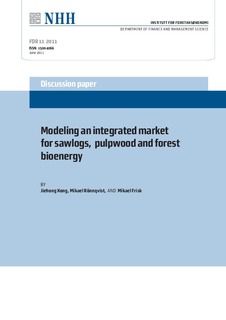| dc.description.abstract | Traditionally, most applications in the initial stage of forest supply chain deal with sawlogs to sawmills,
pulpwood to pulp or paper mills and forest residues to heating plants. However, in the past decades, soaring prices
of fossil fuel, global awareness about CO2 emission and increasing attention to domestic resource security have
boosted the development of alternative renewable energy, among which forest bioenergy is the most promising
and feasible choice for medium- and large-scale heating and electricity generation. Different subsidies and
incentive policies for green energy further promote the utilization of forest bioenergy. As a result, there is a trend
that pulpwood may be forwarded to heating plants as complementary forest bioenergy. Though pulpwood is more
expensive than forest residues, it is more efficient to transport and has higher energy content. The competition
between traditional forest industries and wood-energy facilities, expected to grow in the future, is very sensitive
for the forest companies as they are involved in all activities. In this paper, we develop a model that all raw
materials in the forest, i.e. sawlogs, pulpwood and forest residues, and byproducts from sawmills, i.e. wood chips
and bark, exist in an integrated market where pulpwood can be sent to heating plants as bioenergy. It represents a
multi-period multi-commodity network planning problem with multiple sources of supply, i.e. pre-selected
harvest areas, and multiple kinds of destination, i.e. sawmills, pulp mills and heating plants. The decisions
incorporate purchasing the raw materials in harvest areas, reassigning byproducts from sawmills, transporting
those assortments to different points for chipping, storing, wood-processing or wood-fired, and replenishing fossil
fuel when necessary. Moreover, different from the classic wood procurement problem, we take the unit
purchasing costs of raw materials as variables, on which the corresponding supplies of different assortments
linearly depend. With this price mechanism, the popularity of harvest areas can be distinguished. The objective of
the problem is to minimize the total cost for the integrated market including the purchasing cost of raw materials.
Therefore, the model is a quadratic programming (QP) problem with a quadratic objective function and linear
constraints. A large case study in southern Sweden under different scenario assumptions is implemented to
simulate the integrated market and to study how price restriction, market regulation, demand fluctuation, policy
implementation and exogenous change in price for fossil fuel will influence the entire wood flows. Pair-wise
comparisons show that in the integrated market, competition for raw materials between forest bioenergy facilities
and traditional forest industries pushes up the purchasing costs of pulpwood. The results also demonstrate that
resources can be effectively utilized with the price mechanism in supply market. The overall energy value of
forest bioenergy delivered to heating plants is 23% more than the amount in the situation when volume and unit
purchasing cost of raw materials are fixed. | no_NO |
